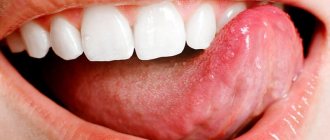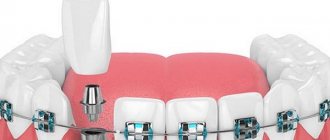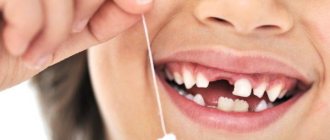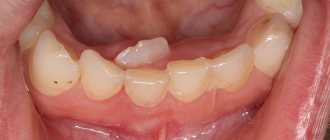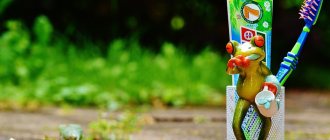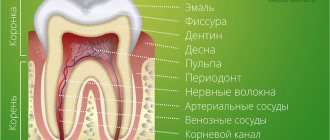Drawing a smiling sun
First we draw a circle, it will be the basis of the image. You can use a compass or trace an object (such as a coin).
Now let's designate the location of the spokes. They can be depicted in different ways: lines, stripes, in the form of trapezoids, triangles, in the form of drops, sunflower petals. The rays can be of different sizes, so the sun will look even more interesting. Choose the shape you like and draw. Erase the basting lines with an eraser.
To make the sun friendly and optimistic, we draw joyful eyes, a small nose, eyebrows and a smile. It can be depicted as a line with raised ends in a U shape in a semicircle. Or you can use the example in the article and look at the photo on how to draw a sun with a smile that reveals your teeth. Add freckles, a bow and handles to make the lamp even more beautiful. Draw all the contours again so that they become lighter and color the drawing.
Smile with uneven teeth or no teeth
Not everyone has been blessed by nature with beautiful, straight teeth. And some of them died during their lives. But expressing joyful emotions, everyone smiles. Even without teeth. Not everyone has the financial means to clean up the mess, or are you afraid of panicked dentists? Then a closed smile is suitable for you, without exposing your teeth.
If the natural color of your enamel is yellowish and you cannot cope, you need to visit a dentist and undergo a hardware whitening procedure. This is the only way to achieve the desired white color. And all the tricks with toothpaste remain just a successful PR move.
Practical advice
- Find the time, finances and courage to get your teeth in order. The most fervent laughter consists of opening your mouth and exposing your teeth. Otherwise, you will have to constantly cover yourself with your palm.
- Only a sincere smile can attract and bewitch. If you smile with bad intentions, it will look like a smile and others are unlikely to like it. Your eyes should laugh too, because they are called the mirror of the soul.
- Train your facial muscles. In front of the mirror, try to smile so that symmetry appears on your face. It may not work out the first time. When you achieve the desired result, look at the symmetrical smile for a couple of minutes. If you do this regularly, your facial expressions will become accustomed and your muscles will hear you more clearly.
- Take care of your lips. If you don't wear makeup, apply lipstick and give up the bad habit of constantly licking your lips.
%C2%A0
Dystopic and impacted wisdom teeth –
From the word “retention” - delay in eruption. Thus, an impacted wisdom tooth is the eighth tooth that cannot erupt for a long time. This may be due to lack of space in the dentition (for example, due to insufficient length of the lower jaw), or due to the complete or partially horizontal position of the tooth in the jaw. Impacted eighth teeth pose quite a danger to the bite, because... if there is insufficient space for eruption, they will push adjacent teeth, moving them towards the center. Accordingly, this will lead to crowding of the front teeth.
What impacted wisdom teeth look like -
In turn, a wisdom tooth is called dystopic when it has fully erupted, but not quite correctly. For example, it may be in an incorrect position, located not along the arch of the dentition, but, for example, closer to the cheek (or the tooth may have a strong buccal or lingual inclination). The decision to preserve such teeth is made by the dentist on an individual basis. For example, if, when closing the teeth, it injures the mucous membrane of the cheek, the patient is sent for removal.
What do dystopic wisdom teeth look like?
Funny tooth with brush and paste
It is very important to teach children hygiene, including oral hygiene. And it is equally important to do this in a form accessible to children. For example, in creativity. To do this, you can, for example, learn to draw human teeth. With a brush and ready-made paste.
The first step is to outline the shape. We draw in general, as in a school biology textbook.
Then we will draw a muzzle for the tooth. After all, this is quite a cartoon character telling children about the rules of dental care. So let's give him big eyes, slightly raised eyebrows and a joyful smile.
Now let's draw two small hands. In them, the tooth firmly holds the toothbrush and tube of toothpaste.
Let's color the drawing. The tooth will be white (except for pink gloves and a smile). Both the brush and the hose are blue. But let's make the bristles on the brush bright orange for contrast.
Our painting is now completely complete. You can hang this photo in the bathroom so that your child does not forget about oral hygiene in the morning. It also helps cope with childhood fear of the dentist.
Milk teeth in children: structure, quantity, timing of eruption
Teeth (deciduous and permanent) are bone formations. They are designed to carry out the process of mechanical processing of food, the so-called mastication, in order to prepare it for subsequent digestion.
As for the anatomical structure of baby teeth, it is in many ways similar to the structure of adult teeth, although there are some important differences.
The part of the tooth located above the gum is called the crown. The surfaces of the crowns can be of different shapes depending on which particular tooth we are talking about, but in any case, in baby teeth they are much smaller in size.
The crown is connected to the root through a neck - a slightly narrowed part, around which connective fibers are located in the horizontal plane, forming the so-called circular ligament.
The root itself is located in a small depression called the alveolus. Vessels that supply nutrition to the tooth and nerves pass through a special hole in the apex of the root. Most people are mistaken in believing that baby teeth do not have roots. In fact, those of them that are intended for chewing food (molars) are also molars, only their roots are independently absorbed by the time they are replaced by permanent ones.
What is inside the crown? A photo of the structure of a baby tooth helps you find out:
- Any milk tooth, like a permanent one, is covered with enamel.
Only in temporary teeth it is much thinner and softer, and not so mineralized, which is why in children caries develops rapidly and can turn into pulpitis or periodontitis in a few weeks.
- Beneath the enamel is dentin, which is also much thinner than in permanent teeth.
This is the highly mineralized underlying tissue surrounding the tooth cavity and root canal. It is slightly inferior in strength to enamel. Dentin in the direction from the center is completely pierced by special tubules, through which impulses are transmitted and all metabolic processes occur.
- Dentin, closer to the root system, covers cement, to which the fibers of the ligamentous apparatus - periodontium - are attached.
- The internal cavity of the crown and root of the tooth is filled with pulp - very soft internal tissue in which nerves and blood vessels are located.
It plays a major role in providing the tooth with nutrients and carrying out metabolic processes. When the pulp is removed, metabolic processes in the tooth become impossible.
In baby teeth, the volume of the pulp is much larger, and the root tubules are wider than in permanent teeth.
In addition to the structural features of baby teeth, parents are concerned about the timing of their eruption and how many teeth should be normal at a given age of the baby. Let's look at these questions in more detail.
How to find your angle?
First, figure out how wide your mouth can be. It all depends on the condition of your mouth and the health of your teeth. Smiling in front of the mirror, you can understand this moment. You should have a natural, relaxed smile that will highlight your best features. The mirror will help you with this like no other.
Notice what your gaze is doing now. Squinting your eyes slightly will complement your smile with naturalness and sincerity. This is an excellent solution for those who want to divert attention from imperfect teeth. The Duchenne smile is a heart condition that cannot be simulated. Be honest.
Wear colorful jewelry that may draw attention away from your lips. Unusual earrings with stones are perfect for this. Create an interesting hairstyle, wear a scarf or other fun accessory.
Ask a friend to take photos of you from different angles. Using the finished photographs, it will be easier for you to understand from which side and at what angle it is best to photograph in your case.
Be happy and bring happiness to others!
Teeth with a simple pencil - mastering basic drawing techniques
The pencil is a fundamental tool that any self-respecting artist should master. Then we work with the pencil technique and at the same time learn how to draw a tooth with a pencil.
First, let's draw the main lines: vertical axis, horizontal axis, general shape. All this is done to ensure that the lips are symmetrical.
Then we designate the height of the teeth themselves. It shouldn't be too big because some of them will be covered by the lips.
We draw the teeth on the lower jaw, and also mark the gums on the upper jaw.
Next we will also deal with the upper jaw.
In the final stage, all additional lines must be cleared and all main lines must be carefully placed.
That's all, we completely coped with the task. It's not that difficult, right?
Eruption of wisdom teeth -
The rudiments of all permanent teeth are formed in the prenatal period (i.e., during the intrauterine period of fetal development), but it happens completely differently with wisdom teeth.
The rudiments of the eighth teeth are formed in a child only at the age of 4-5 years. As for the process of eruption itself, most permanent teeth erupt between the ages of 6 and 12-13 years, with the only exception being the wisdom tooth. It usually begins its eruption no earlier than 18-21 years old, but this can still happen either at 14 or 40 years old. On the x-ray (Fig. 5) you can see a wisdom tooth in the process of erupting in a 20-year-old young man. The tooth has a fully formed crown, but the roots of the tooth are still in the process of formation and the x-ray shows how underdeveloped they are (24stoma.ru).
Thus:
- the crown of the eighth tooth completes its formation at approximately 12 years of age,
- The eruption of wisdom teeth usually begins no earlier than 18-21 years of age,
- The end of root formation occurs no earlier than 24 years.
On the radiograph (Fig. 6) you can see the wisdom teeth of the upper and lower jaws. The x-ray shows that the roots of the eighth teeth are already fully formed - therefore we can immediately say that this is a photograph of an adult. The lower wisdom tooth occupies a horizontal position, which generally excludes the possibility of its eruption. As for the upper wisdom tooth, in this case its crown rests against the tooth in front, and therefore complete eruption of the 8th tooth will probably occur only after the removal of the 7th tooth.
In Fig. 7 you can see the lower wisdom tooth in a state of eruption (view in the oral cavity). The tooth is at the stage of eruption when the chewing surface of the tooth crown is covered only by the mucous membrane, and one of the cusps of the tooth crown is already peeking out from under the mucous membrane. Very often, the mucous membrane over the wisdom tooth becomes inflamed, and this disease is called pericoronitis.
Smile from ear to ear - let's draw together
A smile is one of the sunniest and brightest phenomena. Of course, if it is caused by something good. Let's get into this fun mood and learn how to draw a smile with teeth.
First of all, draw the general contours of the lips. Since the mouth will be slightly open, draw the outline wider than when the mouth is closed.
Then we will separate the upper lip, lower lip and the space between them.
Then we will finalize the upper jaw. The teeth should not be the same size, otherwise the smile will resemble a fence.
Now let's repeat the same with the lower jaw. Only here the size of the teeth will be slightly smaller.
After that, let's color our drawing. Let's make the lips a rich red, the inside of the mouth pink, and the area around it a pale pink.
That's it, we completed the task.
Advice from psychologists
One more thing should be said about the miraculous power of a smile. He is able to cheer up even the person from whom he comes from. Psychologists advise immediately after waking up to smile at yourself - warmly, dreamily and gently stretch. It is also worth thinking that the coming day will be positive and successful. Only then will you be able to get out of bed and start your morning routine. It is very important that this seemingly insignificant ritual becomes everyday. When you start thinking positively, you will see how your life will soon change. Smile, laugh as often as possible, and not just in front of the camera.
We hope that after reading this article, you received the answer to the question of how to smile beautifully and will be able to shine with a radiant smile. And one last piece of advice. Look at the smiling face of the child, kind and sincere. Babies cannot smile under duress, which is why their smile is so real. Try it and you will follow their example. Laugh like you don't have a problem, enjoy life for whatever reason, and ignore the stereotype that Russians are people without a smile. You can change this opinion.
Functions of a smile
A person’s smile originates in the brain, in its subcortical region (limbic system). By definition, a smile is a reaction to an external stimulus. If you like something, you get positive emotions. If not, then negative.
Each emotion triggers different biochemical processes in the brain. They cause visible changes in the body. A clear example is expressive reactions. This is an external expression of emotions, proof that a person has some experiences, whether they are good or bad.
A smile in psychology is also considered an expression of emotions. If the face of your interlocutor does not express anything, of course, you will treat him with some uncertainty. Even a slight facial expression and a slight smile will change the situation for the better and can evoke love. It is not true?
A smile has other functions.
Communicative
In psychology, smiling is considered one of the ways of non-verbal communication. One of his responsibilities is to tell others what emotions a person is experiencing right now. And that is not all:
- Anyone who smiles automatically inspires confidence in others and instills in them a sense of security.
- Smiling and laughter are contagious. Therefore, by smiling, you can set your interlocutor in a positive mood. Often a smile appears on a person’s face even when viewing photographs of smiling people.
- Using this method of conveying emotions, you can easily express everything you feel right now. We are talking not only about positive emotions, but also about sympathy, apology, contempt, etc.
- A smile tells you what kind of person you are in front of you. It can be used to judge sincerity, good character, and aggression.
In addition, a smile is a corporate communication tool. Its absence can greatly interfere with communication.
The structure of the tooth.
A tooth is a bone located in the alveolar process of the jaw and consisting of various hard tissues (enamel, dentin, cement) and soft tissues (dental pulp). Anatomically, the following parts of the tooth can be distinguished:
- crown of the tooth (the part of the tooth protruding above the gum);
- tooth root (part of the tooth located in the jaw);
- neck of the tooth (a conventionally distinguished part of the tooth, which is a transitional area from the crown of the tooth to the root, covered with a thin layer of enamel)
The crown of the tooth is covered with enamel, the hardest tissue in the body, consisting of hydroxyapatite crystals. Beneath the enamel is a softer, more porous tissue called dentin. On the crown of the chewing tooth there are tubercles and fissures. Fissures are natural depressions on the chewing surface of the teeth between the cusps. Deep fissures are often the cause of the development of the carious process, because... a lot of plaque remains in them.
Inside the tooth there is a cavity containing pulp. The pulp of a tooth, in common parlance, the “nerve” of a tooth, is a neurovascular bundle consisting of blood vessels and a nerve. The neurovascular bundle provides nutritional function and replenishment of the composition of tooth tissue.
Each group of teeth differs in their structure, shape and function:
- incisors - involved in biting off food;
- fangs - provide “tearing off” and holding food;
- molars and premolars - are involved in grinding food to create an optimal digestive bolus.


